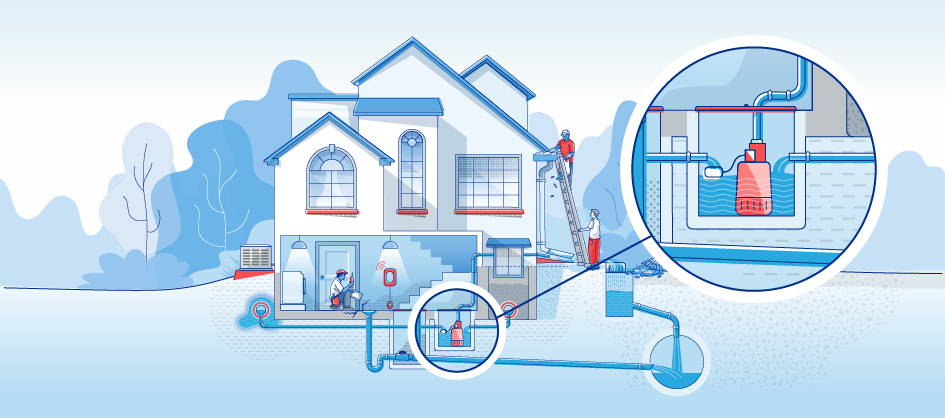All
Protecting Your Home Against Flooding: Digging Deeper into Sump Pumps
January 30, 2025
3 minute read

Protecting your home against flooding is critical, since water can get in due to heavy rainfall, sewer backups, or an overflowing body of water. The good news is that there are preventative maintenance steps you can take that don’t require technical expertise. To further protect your home from flooding, consider making additional improvements, such as installing a sump pump.
When it comes to installing a sump pump, you will want to call in a licensed and insured professional to help. According to the Institute for Catastrophic Loss Reduction, professional installation ensures the system is set up correctly and efficiently. Here’s what you should know to help you get started.
What does a sump pump do?
Your home’s weeping tiles collect and redirect water away from its foundation. They are installed underground in a sloped trench to help water flow away from the house. Water can get into your weeping tiles via downspouts, through the backfill zone behind your home, or via the water table.
When water doesn’t drain properly, installing a sump pump in your basement can help pump water up and away from the weeping tiles. The sump pump directs water to the earth’s surface, a seepage pit, or a drainage ditch beside the road.
How do I know if I need a sump pump?
Consider the following situations:
Do you live in an area with frequent or intense rainfall?
Is your home built on a high-water table?
Does the soil around your home retain water?
Is there a river, lake, or other body of water nearby?
Do you live in a rural area that does not have a municipal storm and/or sanitary sewer systems?
How do sump pumps work?
Once the water in the sump pump pit reaches a certain height, the pump will be activated to force water up the discharge pipe, and out of the house to the surface, preferably away from the home’s foundation and onto grass or into a garden.
Ensure that your sump pump directs water away from your home’s foundation, backfill zone, and your neighbour’s property. Also, keep water away from patios, driveways and walkways because these will freeze in the winter. Direct water away from reverse slope driveways since water can flow back into your home.
What should I look for when choosing a sump pump?
There are three things to consider when buying a sump pump: the type of pump (submersible vs pedestal), how much water it can pump per hour and its horsepower.
What’s the difference between a submersible or pedestal sump pump?
Submersible sump pumps tend to be the most common type—likely because they are more powerful and can get rid of large amounts of basement water quickly. As their name suggests, these sump pumps sit down inside a pump basin and are covered by water. Since the motor is covered by water, their sound is muffled, making it a much quieter option than pedestal models.
Pedestal sump pumps are a good solution if you live in an area that doesn’t get heavy rainfalls because their pumping capacity is considerably less, and they generate less horsepower. On the plus side, pedestal sump pumps are easier to install, maintain and tend to last longer since they aren’t submerged in water.
How can you tell if your sump pump is working?
Like anything else, sump pumps must be regularly maintained and inspected to ensure they’re working properly. To check, pour water into the sump pit and see if the pump starts automatically (it should). If you notice your sump pump is:
Making loud noises
Taking too long to pump out water
Running constantly and not turning off
Operating with the float switch stuck in the “on” position
Clogging often
Appearing to have oil in the sump pit
You will want to call a licensed and insured professional plumber. Usually, a sump pump needs to be replaced every ten years.
Sump pumps are powered by electricity, so when there’s a power failure your sump pump won’t work. Water will continue to collect in your sump pump pit. You will need to either empty it manually or have an auxiliary power source to operate the pump. Talk to your plumber or electrician about backup pumps, backup batteries and sump pump alarms.
Installing a sump pump and ensuring it is working well can help guard against water entering and damaging your home. By following these simple steps, you can help protect your home and reduce your likelihood of having to face the stressful aftermath of a flood.
This content is intended to provide general information only and is not intended to provide legal or professional advice, or to be relied on in any dispute, claim, action, demand or proceeding. CAA Insurance Company does not accept liability for any damage or injury resulting from reliance on this information.
